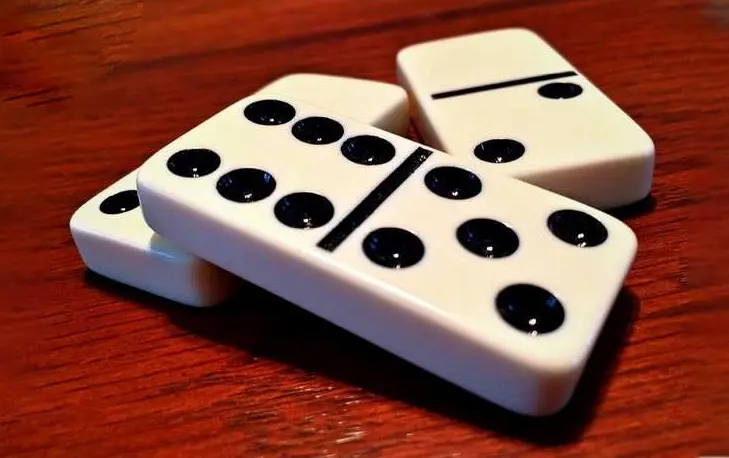How To Play Dominoes

It's hard to pinpoint exactly how long the game of dominoes has been around, but most historians believe it was invented in China around the year 1120. That makes it roughly 900 years old.
There aren't many games around today that people have been playing for centuries. There might be new variations, like Mexican Train and Chickenfoot, but the games of straight dominoes have had plenty of time for players to figure out the best strategy.
Let's look at how to play dominoes and, more importantly, how to win.
What Makes Up a Classic Dominoes Set?
A standard dominoes set, also called a deck, includes 28 dominoes. A standard set is designed for 2 to 4 players, but you can find larger decks intended for larger groups. We recommend starting with a standard 28-dominoes deck when learning how to play Dominoes.
The dots on each tile, called pips, represent the 21 number pairs that you can throw on a standard pair of dice plus seven more tiles with a blank (or zero).
How to Play Dominoes
In a game of dominoes, players take turns placing a tile on the table by matching one face with a face already played.
The goal is normally to score the highest number of points, although some variations consider the winner as the first player to get rid of all their tiles.
Luck plays a part in winning dominoes, but playing strategically is just as important, if not more so.
Rules for Playing Dominoes
Dominoes is actually a fairly simple game, so don't get stressed about whether you can learn how to play dominoes or not, you'll get it in no time. To start the game, all tiles get placed face-down on the table and one player shuffles them by randomly mixing them around the surface.
After shuffling, each player draws one tile to determine who plays first. The player who draws the highest double plays first or if no double gets drawn, the player with the highest-scoring tile.
Once you know who plays first, each player draws 7 tiles from the deck. The player who shuffled them chooses last.
If there are tiles left on the table after the draw, they remain face-down and get drawn if a player can't play any of the tiles in their hand.
The first player places a tile face-up on the table. The next player has to match the number of pips on one of the two halves of that tile. They place a tile by connecting the matching halves.
Some versions of dominoes let players place tiles on all 4 sides of the first tile played, creating more open lines to build on.
Players can add their tile to any line that matches the number of pips on one end. If a player plays a double, that tile gets placed perpendicular to the line and both halves of the tile are counted for the score.
If a player doesn't have any tiles that they can play, they draw one from the spare tiles that are still face-down from the shuffle.
How to Score Dominoes
You win points in dominoes in a couple of ways:
- The table layout
- What other players are holding
In straight dominoes, a player earns points for any line that has an exposed pip that you can divide by 5. In other words, any tile at the end of the line that can be divided by 5.
Some versions of the game count tiles divisible by 3 instead.
If someone plays their last domino, they also score the number of pips that each of the other players has remaining in their hand.
Most dominoes games get played to a preset score, such as 100 or 200. If you're looking for a quick game, you can also consider the first player to get rid of all their tiles as the winner.
If you reach a point where none of the players can play a tile, the game is "blocked". In this case, the winner is the player with the fewest pips left in their hand. They score the total pips in all the other players' hands.
Winning Dominoes Strategies
There are two important factors to focus on when learning how to play dominoes:
- Don't get stuck with unplayable tiles
- Don't get stuck with high-scoring tiles
Try to play doubles early in the game. Because both ends have the same number of pips, it limits your options.
Play higher-scoring tiles early as well. If you hold onto them and another player wins the game, those points could all go to them.
Try to keep a range of numbers in your hand so you have more flexibility as the game progresses.
Pay attention when other players pass. Remember what numbers are in play so you know what they're missing.
As the game gets further along, keep an eye on the tiles that are already on the table. If you know what's already played and what numbers your opponents have passed on, you can make a solid guess at what tiles they could be holding.
It's similar to counting cards in a Las Vegas casino, except you can see all the tiles in play. If you know what's already missing from the deck, you can reverse-engineer that knowledge to figure out what's left.
This can help you make strategic plays that can both block your opponents and give you opportunities when you draw another tile.
Where to Play Dominoes Online
Now that you know how to play dominoes, you're probably itching to put your newfound skills to work. Fortunately, you don't need to go searching for an opponent - you can play online any time you please.
CoolMathGames.com offers two free online dominoes games - Domino Dash and regular Dominoes.
Visit our playlist of different dominoes variations here and start honing your dominoes skills and you'll be ready for any challenger!